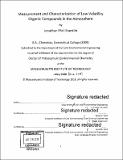Measurement and characterization of low volatility organic compounds in the atmosphere
Author(s)
Franklin, Jonathan Pfeil
DownloadFull printable version (11.52Mb)
Other Contributors
Massachusetts Institute of Technology. Department of Civil and Environmental Engineering.
Advisor
Jesse H. Kroll.
Terms of use
Metadata
Show full item recordAbstract
Organic aerosol is a central topic in environmental science due to its role in climate forcing and negative health effects. The transformation of organic species from primary gas phase emissions to secondary organic aerosol (SOA) is highly complex and poorly understood, proving difficult for even stateof- the-art computational models to predict. This thesis describes the in-depth characterization and redesign of a previously developed technique for the quantification of intermediate volatility organic compounds (IVOCs), which are compounds with saturation vapor pressures of 10³-10⁷ [mu]g/m³. This analytical technique, the thermal-desorption electron ionization mass spectrometer (TD-EIMS) provides a volatility separated, bulk measurement of IVOCs and will be used to investigate the primary emissions as well as production and evolution of IVOCs in a series of experiments described in this thesis. Primary emissions of IVOCs have been previously measured in vehicle exhaust and have been theorized as a significant precursor to secondary organic aerosol (SOA) in urban atmospheres. IVOCs are predominately emitted during cold start periods, but maintain a similar chemical composition across all engine states. As emissions controls have tightened, emissions of non-methane hydrocarbons and primary particulate matter have decreased, however emissions of IVOCs have only decreased significantly (as much as 80%) between the newest ULEV and SULEV emissions control tiers. Laboratory studies examining the atmospheric oxidation of common biogenic and anthropogenic SOA precursors in environmental "smog" chambers show different production and evolution profiles of IVOCs. The comparison of IVOCs measured by the TD-EIMS with other analytical techniques sampling in parallel show the TD-EIMS may detect a previously characterized fraction of carbon. Production of secondary low volatility organic compounds can also occur in low oxygen systems, such as in planetary atmospheres or in the process of soot formation. Ultraviolet light or heat can form radical hydrocarbon species, which, in low oxygen environments, will react with other hydrocarbon or radical species, undergoing oxidation by molecular growth. Particles made from ethane and ethylene are composed of very saturated compounds. The particles produced from the photolysis of acetylene are fundamentally different showing significantly larger molecule sizes and substantially higher degrees of unsaturation. The results from this thesis demonstrate measurements of the production and evolution of primary and secondary low volatility organic gases by new analytical techniques and provide a new insight to the complex chemical processes in the atmosphere leading to the production of secondary organic aerosol.
Description
Thesis: Ph. D. in Environmental Chemistry, Massachusetts Institute of Technology, Department of Civil and Environmental Engineering, 2018. Cataloged from PDF version of thesis. Includes bibliographical references.
Date issued
2018Department
Massachusetts Institute of Technology. Department of Civil and Environmental EngineeringPublisher
Massachusetts Institute of Technology
Keywords
Civil and Environmental Engineering.